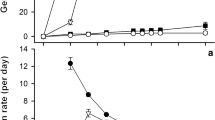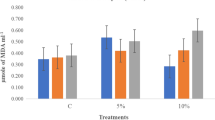Abstract
Catharanthus roseus is a great medicinal plant used for treating diseases such as cancer, as it contains different biochemicals including terpenoids. Salinity is a major stress, significantly decreasing the growth and yield of medicinal plants, worldwide. However, to our knowledge, there is not any data on the growth improvement in C. roseus seedling under salinity stress using the priming techniques tested in the presented research. The objective was to investigate the effects of seed priming including hydro- (distilled water), osmo- (KNO3 1%), and hormonal priming (salicylic acid, SA 0.5 mM) on the seedling growth of C. roseus under natural salinity (salt obtained from Qom Lake, Iran) of 0, 2.95, 5.66, 8.13, and 10.66 dSm−1. The treated seeds were grown in Petri dishes and placed in a germinator (25 ± 1 °C) for germination and the growth of seedlings. The plant seedlings were planted in the greenhouse conditions and treated during the V6–V8 growth stage with the salinity treatments (a factorial design on the basis of a completely randomized block design with three replicates) under hydroponics conditions. Different morphological properties of C. roseus including the length and the dry weight of rootlet, plumule, and seedling as well as leaf relative water content (RWC) were measured. The results indicated the alleviating effects of different priming techniques on the growth of C. roseus under natural salt stress. Although the effect of priming was not significant on RWC, salt stress and its interaction with priming significantly affected RWC indicating that the alleviating effect of priming on RWC is a function of salinity level. With increasing the level of salinity, rootlet dry weight increased, which indicates the allocation of more carbon to the roots under stress. It is possible to plant C. roseus in saline fields using the priming techniques tested in this research work.







Similar content being viewed by others
Abbreviations
- SA:
-
Salicylic acid
- RL:
-
Root length
- RDW:
-
Root dry weight
- PL:
-
Plumule length
- PDW:
-
Plumule dry weight
- SL:
-
Seedling length
- SDW:
-
Seedling dry weight
- RWC:
-
Relative water content
References
Agami RA (2013) Alleviating the adverse effects of NaCl stress in maize seedlings by pretreating seeds with salicylic acid and 24-epibrassinolide. S Afr J Bot 88:171–177
Bukhat S, Manzoor H, Zafar ZU, Azeem F, Rasul S (2019) Salicylic acid induced photosynthetic adaptability of Raphanus sativus to salt stress is associated with antioxidant capacity. j Plant Growth Regul. https://doi.org/10.1007/s00344-019-10024-z
Çavuşoğlu K, Cadıl S, Çavuşoğlu D (2017) Role of potassium nitrate (KNO3) in alleviation of detrimental effects of salt stress on some physiological and cytogenetical parameters in Allium cepa L. Cytologia 82:279–286
Chang B, Yang L, Cong W, Zu Y, Tang Z (2014) The improved resistance to high salinity induced by trehalose is associated with ionic regulation and osmotic adjustment in Catharanthus roseus. Plant Physiol Biochem 77:140–148
Daei G, Ardekani MR, Rejali F, Teimuri S, Miransari M (2009) Alleviation of salinity stress on wheat yield, yield components, and nutrient uptake using arbuscular mycorrhizal fungi under field conditions. J Plant Physiol 166:617–625
Elouaer MA, Hannachi C (2012) Seed priming to improve germination and seedling growth of safflower (Carthamus tinctorius) under salt stress. Eurasian J Biosci 6:76–84
El Tayeb MA (2005) Response of barley grains to the interactive effect of salinity and salicylic acid. Plant Growth Regul 45:215–224
Ghassemi-Golezani K, Farhangi-Abriz S (2018) Foliar sprays of salicylic acid and jasmonic acid stimulate H+-ATPase activity of tonoplast, nutrient uptake and salt tolerance of soybean. Ecotoxicol Environ Saf 166:18–25
Gupta B, Huang B (2014) Mechanism of salinity tolerance in plants: physiological, biochemical, and molecular characterization. Int J Genomics. https://doi.org/10.1155/2014/701596
Hayat Q, Hayat S, Irfan M, Ahmad A (2010) Effect of exogenous salicylic acid under changing environment: a review. Environ Exp Bot 68:14–25
Hoagland D, Arnon D (1938) The water-culture method for growing plants without soil. Circ Calif Agric Exp Stat 37:1–39
Hussein MM, Balbaa LK, Gaballah MS (2007) Salicylic acid and salinity effects on growth of maize plants. Res J Agric Biol Sci 3:321–328
Ibrahim EA (2016) Seed priming to alleviate salinity stress in germinating seeds. J Plant Physiol 192:38–46
Jafarzadeh AA, Aliasgharzad N (2007) Salinity and salt composition effects on seed germination and root length of four sugar beet cultivars. Biologia 62:562–564
Jha Y, Subramanian RB (2016) Regulation of plant physiology and antioxidant enzymes for alleviating salinity stress by potassium-mobilizing bacteria. In: Potassium solubilizing microorganisms for sustainable agriculture. Springer, New Delhi, pp 149–162
Joseph B, Jini D, Sujatha S (2010) Insight into the role of exogenous salicylic acid on plants grown under salt environment. Asian Journal of Crop Science 2:226–235
Kang G, Li G, Zheng B, Han Q, Wang C, Zhu Y, Guo T (2012) Proteomic analysis on salicylic acid-induced salt tolerance in common wheat seedlings (Triticum aestivum L). Biochim Biophys Acta (BBA) 1824:1324–1333
Kim Y, Mun BG, Khan AL, Waqas M, Kim HH, Shahzad R, Imran M, Yun BW, Lee IJ (2018) Regulation of reactive oxygen and nitrogen species by salicylic acid in rice plants under salinity stress conditions. PLoS ONE 13:e0192650
Li G, Peng X, Wei L, Kang G (2013) Salicylic acid increases the contents of glutathione and ascorbate and temporally regulates the related gene expression in salt-stressed wheat seedlings. Gene 529:321–325
Li W, Jin C, Guan D, Wang Q, Wang A, Yuan F, Wu J (2015) The effects of simulated nitrogen deposition on plant root traits: a meta-analysis. Soil 82:112–118
Liang W, Ma X, Wan P, Liu L (2018) Plant salt-tolerance mechanism: a review. Biochem Biophys Res Commun 495:286–291
Mengel K (2016) Potassium. In: Handbook of plant nutrition. CRC Press, pp 107–136.
Miransari M, Bahrami HA, Rejali F, Malakouti MJ (2008) Using arbuscular mycorrhiza to alleviate the stress of soil compaction on wheat (Triticum aestivum L.) growth. Soil Biol Biochem 40:1197–1206
Miransari M (2013) Soil microbes and the availability of soil nutrients. Acta Physiol Plant 35:3075–3084
Miransari M, Smith DL (2014) Plant hormones and seed germination. Environ Exp Bot 99:110–121
Miransari M, Smith D (2019) Sustainable wheat (Triticum aestivum L.) production in saline fields: a review. Crit Rev Biotechnol 39:999–1014
Misra N, Gupta AK (2006) Effect of salinity and different nitrogen sources on the activity of antioxidant enzymes and indole alkaloid content in Catharanthus roseus seedlings. J Plant Physiol 163:11–18
Mohammadi M, Asadi-Gharneh HA (2018a) How the morphological properties of Mentha longifolia. (L.) Huds. may be affected by geographical differences. J Photochem Photobiol B 178:237–242
Mohammadi M, Asadi-Gharneh HA (2018b) How geographical differences may affect the uptake of nutrients by the wild populations of pennyroyal [Mentha longifolia. (L.), Huds]. CATENA 165:173–177
Nabaei M, Amooaghaie R (2019) Interactive effect of melatonin and sodium nitroprusside on seed germination and seedling growth of Catharanthus roseus under cadmium stress. Russ J Plant Physiol 66:128–139
Omidi H, Shams H, Sahandi MS, Rajabian T (2018) Balangu (Lallemantia sp.) growth and physiology under field drought conditions affecting plant medicinal content. Plant Physiol Biochem 130:641–646
Rahnama A, Munns R, Poustini K, Watt M (2011) A screening method to identify genetic variation in root growth response to a salinity gradient. J Exp Bot 62:69–77
Ritchie S, Nguyen H (1990) Leaf water content and gas exchange parameters of two wheat genotypes differing in drought resistance. Crop Sci 30:105–111
Sahoo S, Borgohain P, Saha B, Moulick D, Tanti B, Panda SK (2019) Seed priming and seedling pre-treatment induced tolerance to drought and salt stress: recent advances. In: Priming and pretreatment of seeds and seedlings. Springer, Singapore, pp 253–263
Shin R, Berg RH, Schachtman DP (2005) Reactive oxygen species and root hairs in Arabidopsis root response to nitrogen, phosphorus and potassium deficiency. Plant Cell Physiol 46:1350–1357
Sohag AAM, Tahjib-Ul-Arif M et al (2020) Exogenous salicylic acid and hydrogen peroxide attenuates drought stress in rice. Plant Soil Environ 66:7–13
Soleymani A (2019) Safflower (Carthamus tinctorius L.) seed vigor tests for the prediction of field emergence. Ind Crops Prod 131:378–386
Song WY, Yang HC, Shao HB et al (2014) The alleviative effects of salicylic acid on the activities of catalase and superoxide dismutase in malting barley (Hordeum vulgare L.) seedling leaves stressed by heavy metals. CLEAN–Soil Air Water 42:88–97
Tahaei A, Soleymani A, Shams M (2016) Seed germination of medicinal plant, fennel (Foeniculum vulgare Mill), as affected by different priming techniques. Appl Biochem Biotechnol 180:26–40
Tahjib-UI-Arif M, Sohag AAM, Afrin S, Bashar KK, Afrin T, Mahamud AGM, Polash MAS, Hossain M, Sohel M, Taher A, Brestic M (2019) Differential response of sugar beet to long-term mild to severe salinity in a soil–pot culture. Agriculture 9:223
Thalmann M, Pazmino D, Seung D, Horrer D, Nigro A, Meier T, Kölling K, Pfeifhofer HW, Zeeman SC, Santelia D (2016) Regulation of leaf starch degradation by abscisic acid is important for osmotic stress tolerance in plants. Plant Cell 28:1860–1878
Thion CE, Poirel JD, Cornulier T, De Vries FT, Bardgett RD, Prosser JI (2016) Plant nitrogen-use strategy as a driver of rhizosphere archaeal and bacterial ammonia oxidiser abundance. FEMS Microbiol Ecol. https://doi.org/10.2136/sssaj2016.06.0179
Tonk D, Mujib A, Ali M, Zafar N (2017) Elicitors enhance alkaloid yield in Catharanthus roseus. In: Catharanthus roseus. Springer, pp 101–119
Yan K, Shao H, Shao C, Chen P et al (2013) Physiological adaptive mechanisms of plants grown in saline soil and implications for sustainable saline agriculture in coastal zone. Acta Physiol Plant 35:2867–2878
Zamani S, Naderi MR, Soleymani A, Nasiri BM, Miransari M (2020) Sunflower (Helianthus annuus L.) biochemical properties and seed components affected by potassium fertilization under drought conditions. Ecotoxicol Environ Saf 190:110017
Funding
There was not any funding for this research.
Author information
Authors and Affiliations
Corresponding author
Ethics declarations
Conflict of interest
The authors declare they do not have any conflict of interest.
Additional information
Publisher's Note
Springer Nature remains neutral with regard to jurisdictional claims in published maps and institutional affiliations.
Rights and permissions
About this article
Cite this article
Ghasemi, N., Omidi, H. & Bostani, A. Morphological Properties of Catharanthus roseus L. Seedlings Affected by Priming Techniques Under Natural Salinity Stress. J Plant Growth Regul 40, 550–557 (2021). https://doi.org/10.1007/s00344-020-10118-z
Received:
Accepted:
Published:
Issue Date:
DOI: https://doi.org/10.1007/s00344-020-10118-z




